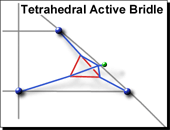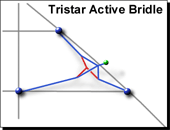Trihedral Active Bridle
A Trihedral Active Bridle is one which has 3 activator legs which can be arranged in different ways. This page describes 2 different Trihedral Active Bridle configurations, the Tetrahedral and Tristar Active Bridles.
This is the Tetrahedral Active Bridle. It is the natural extension of the Dihedral Active Bridle to 3 dimensions: effectively adding an Activator leg to each consequetive pair of bridle legs. Like the Dihedral Active Bridle, the Activator legs may be separated and placed at different distances from the tow point to acheive specific effects. Naturally, the lengths of the legs may also be adjusted. The configuration shown here, with all three Activator legs attached together, is ideal for trick kites and can produce some radical freestyle tricks.
This bridle configuration was originally named the Trihedral Active Bridle. Wim Hendrix was inspired by the original Active Bridle design and has independently developed a configuration based around the same shape (which he correctly identifies as a Tetrahedron) called the Tetrahedron Bridle. In acknowledgment of Wim's efforts, and in keeping with his chosen naming scheme, I've renamed my configuration the Tetrahedral Active Bridle. Thus, the similarity between the two is reflected in the name, but they retain their own individual identities and specific implementations. The term Trihedral Active Bridle is now used to collectively describe all the various 3-dimensional designs shown here.
The Tristar Active Bridle shown here consists of three legs, one attached to each bridle leg, that are then joined together at one central point. Each leg is effectively an Activator controlling the movement of the bridle leg to which it is attached. Because the Activators are joined together, they exert negative feedback on the system by each one naturally resisting (as a result of the tension in the line) the movement of the other Activators. The Activator system, known affectionately as the Space Frame in reference to the kite on which it was originally developed, the Benson Outer Space, maintains an unparalleled stability in the bridle as constantly self-adjusts to balance the pressures exerted on the kite.
The length of each Activator leg can be adjusted, as can its position on the bridle line from the tow point. A well-balanced Space Frame positioned some distance from the tow points, and pulling the bridle lines in only a little, will generally produce a stable, responsive kite that is not only more precise but also capable of increasingly radical tricks.
More extreme positions, with Activators of shorter or uneven lengths, or placed at different distances from the tow point, will produce more radical effects. In general, shortening an Activator leg will move the centre point (where the Activators join) closer to that bridle leg. This will increase the amount of tow point movement (with the bridle under tension) in the direction of that bridle line. Moving an Activator away from the tow point will typically bias the tow point away from that bridle line. It may also have a shortening effect to increase the potential movement in that direction.
See the Dihedral Active Bridle page for further details on the effects of length and placement of Activators.

